While it’s no longer a common everyday writing instrument, a fountain pen need not be intimidating, expensive, or maintenance-intensive. You can find many fountain pens that are inexpensive–but since price and value don’t always line up, we’ve got five great picks from which you can choose!
- History of Fountain Pens, in a Nutshell
- Fountain Pen Terminology
- 5 Highly-Recommended Beginner Fountain Pens
- 1. Pilot Metropolitan – A Fine, Good-Value Fountain Pen
- 2. Pilot Varsity – The Most Inexpensive Fountain Pen
- 3. Jinhao X450 – Huge Bang For The Buck
- 4. Jinhao X750 – Inexpensive Fountain Pen Made in China
- 5. Lamy Safari – Inexpensive Fountain Pen Made in Germany
- Conclusion
- Budget Fountain Pen Recommendations
- Outfit Rundown
In the US, unless they intentionally seek them out, most adults never get acquainted with fountain pens. In Germany, where Raphael grew up, it’s part of the school curriculum, so he first wrote with fountain pens when he was five years old.
Over time, he’s used many different fountain pens–expensive and inexpensive ones. Today, we’ll highlight the five best-value pens that won’t break the bank. If you’re unsure whether a fountain pen is right for you, this guide will focus on low price, easy maintenance, easy writing, and overall, a good experience at a minimal investment.
History of Fountain Pens, in a Nutshell
The fountain pen looks like a more modern variation of the dip pen, but it actually dates back centuries to 973 A.D., when Ma’ād al-Mu’izz, the caliph of the Maghreb, wanted a pen that wouldn’t stain his hands. He was given a pen with a built-in reservoir for the ink that could be held upside down without leaking.

The 1600s saw the invention of
Pens with Ink Reservoir
In the 1600s, pen makers in Germany were producing pens with some kind of ink reservoir. The development improved, and by the late 1600s, fountain pens, as they are known today, were in vogue and being used throughout England.
What was once reserved for the wealthy aristocrat due to cost was now widely available for a minimal price that almost anyone could afford. For the men and women who previously couldn’t afford to write, the fountain pen proved to increase literacy as they began to acquire their own collection of pens.
The knowledge of the pen’s dynamics caught on in the mid-1850s, and from then on, there was a growing number of manufacturers filing patents on a regular basis. Once the free-flowing ink was invented, along with hard rubber and the iridium-tipped gold nib, the industry caught fire, and fountain pens became the standard writing instrument used on an almost global scale.
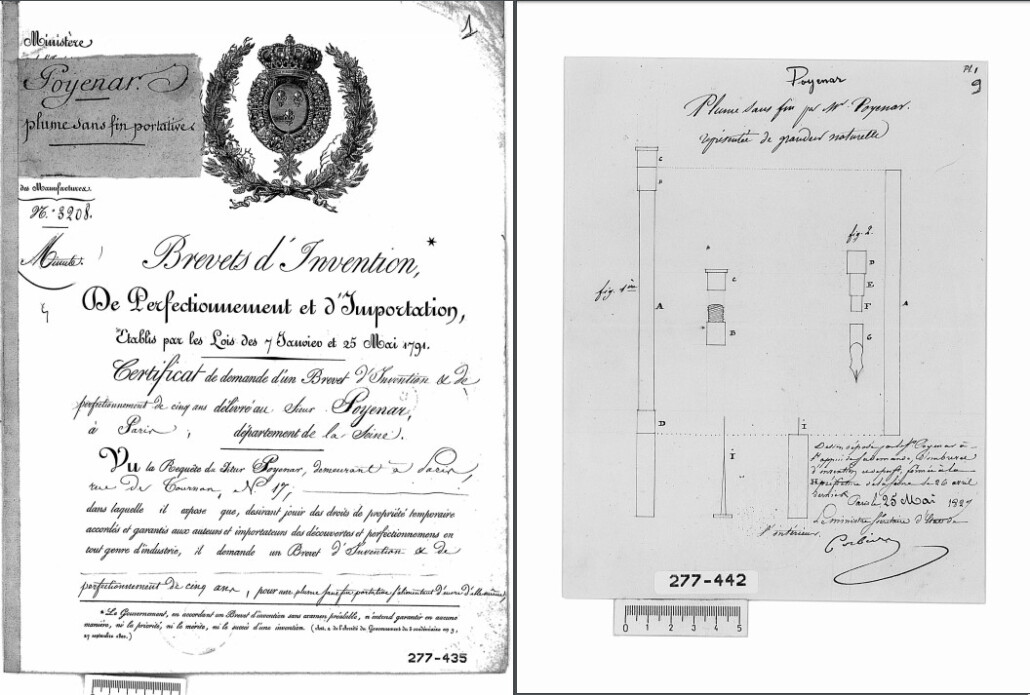
By the 1900s, self-filling pens were developed by companies like Waterman, Parker, and Shaeffer, which had twist, button, and lever fillers. Still, the pens continued to leak, so safety pens were produced, which either consisted of a retracting nib or a screw-on cap that sealed tightly around the nib, preventing it from leaking.
In Germany, concurrently, companies like Pelikan, which had been around since the early 1800s, were beginning to produce fine writing instruments with the more modern piston filler, patented in 1925.
In the 1960s, ballpoint pens were invented and rendered the fountain pen almost useless in many parts of the world including North America. Since then, ballpoints have been the standard writing instrument in America. Across the pond, though, in Europe, we were still using fountain pens in school.
The Rollerball Pen Guide
These days, only those with a particular interest in fine writing instruments know about, own, and use fountain pens, but we think they’re great to have, and that they shouldn’t be too intimidating!
Fountain Pen Terminology
As with any interest or hobby, there’s a lingo in the fountain pen world that we think you need to understand so you can distinguish between the different pens.
The Cap
Basically, the cap is the part of a pen that covers the tip of the pen or the nib. It attaches to the pen’s body. Attached to the cap is the clip, which is a metal strip that allows the pen to hold onto a shirt pocket and keep the pen from rolling off a desk. It can also be a part of one’s style, since some clips are decorative, and there are those that can be bought separately, allowing you to “match your metals.”


Another detail on the cap that keen enthusiasts notice is the finial, which can be found on top of the cap. It is usually designed with the pen maker’s logo.
The Nib
The nib is arguably the most important part. It is the pointed metal piece at the tip of a fountain pen that you write with on a piece of paper. Basically, a fountain pen uses capillary action as well as gravity to get the ink from the inside of the pen through the nib onto the paper.
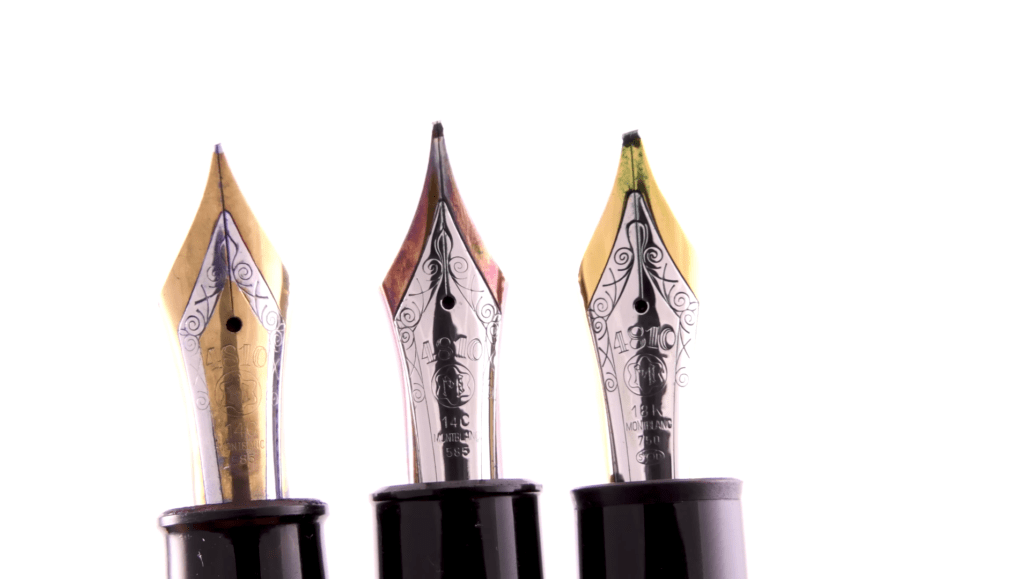
The Ink Feed
Right below the nib, you can find the ink feed which helps the capillary action and to get the ink onto the paper. Unlike ballpoint or rollerball pens, nibs come in different widths. The finest ones are EF, which means extra fine, and then there’s F for fine.

from the INK FEEd
To The Nib
The most common nib is M for medium. If you want a broader nib, you get a B, an even wider one is a BB nib, and if you want it really broad, which is usually only used for signatures, you get an O3b nib. Sometimes, you can also find oblique nibs, which means they’re angled at the tip, and that would, for example, be an OB, which is an oblique broad nib.
When you start for the first time, I suggest you maybe go with a medium nib, a fine, or an extra fine nib, because they’re easiest to learn with, and later on, you can upgrade and invest in more pens with broader nibs.
The Converter
Unlike a ballpoint pen, most fountain pens don’t come pre-loaded with ink. You can either get cartridges, but they’re more expensive per use. Instead, you can use a converter, so you can choose from any kind of ink you want and just fill the ink into it. Usually, they cost anywhere from one to five dollars, but you’ll save money over time compared to a cartridge, which is usually one-time use.
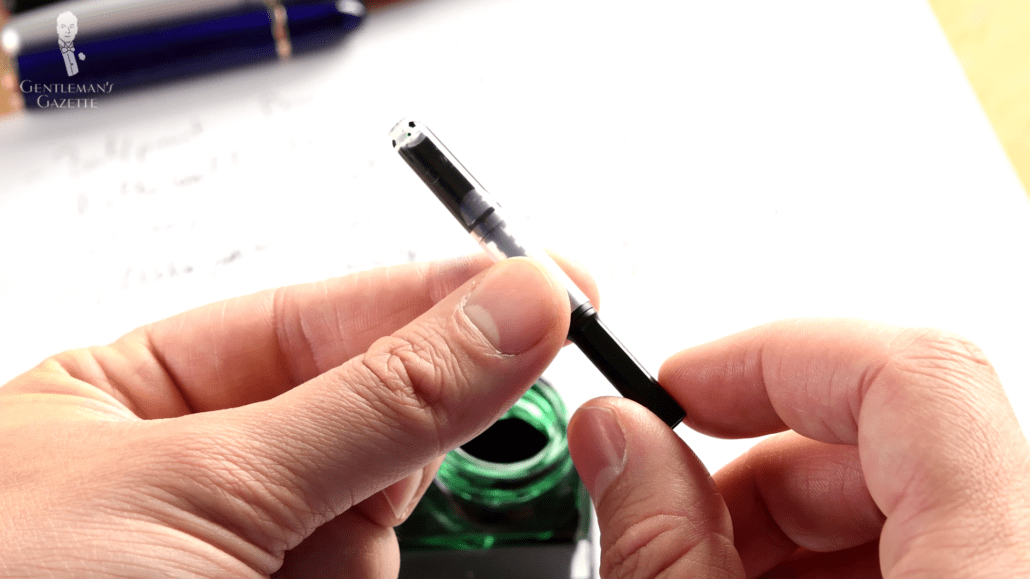
The Piston-Filler
The piston filler doesn’t have a cartridge, and you simply turn the knob at the end of the fountain pen to basically suck ink in or push it back out. This kind of mechanism is commonly found in expensive fountain pens. I am a big fan of the piston fillers or the converters because, down the line, they’re less expensive than cartridges, and they’re also less hard on the environment because you have less waste.


5 Highly-Recommended Beginner Fountain Pens
With the essential knowledge up your sleeve, you might ask, what is a good fountain pen to start with? We’ve got great value, inexpensive fountain pen recommendations today.
1. Pilot Metropolitan – A Fine, Good-Value Fountain Pen
First on our list is the Pilot Metropolitan fountain pen. It was introduced in 2012, and it was universally praised as a really good fountain pen, especially at its price point. It comes in a nice gift box, has a nice weight of about 91 grams, and has very clean lines. It seems durable as well.

It has a fine, Japan-made steel nib, which seems to be high-quality and you can even choose between different nib sizes, which is not something you often find in this price range.
It uses proprietary cartridges and converters, but when you buy a new one, it comes with a converter where you just have to squeeze and let go, which sucks up the ink into the fountain pen, allowing you to increase ink capacity.
Price Point: Retails around $19
2. Pilot Varsity – The Most Inexpensive Fountain Pen
The Pilot Varsity is an easy-to-use, disposable fountain pen. If you want to, it is also refillable with an eyedropper. It’s a very good pen that comes in different finishes, colors, and ink colors, so you can personalize it to your taste. Its design allows you to see the ink supply. The nib is made out of steel, made in Japan.
![Cheap Plastic Fountain Pen Pilot Varsity Disposable Fountain Pen made of cheap plastic [Image Credit: Office Depot]](https://www.gentlemansgazette.com/wp-content/uploads/2022/10/cheap-plastic-fountain-pen-1030x577.jpg)
For what it is, it is really good, not harsh, and definitely, a pen that we recommend to anyone who just wants to start out and who’s not sure if he wants to invest hundreds of dollars into a fountain pen.
Price Point: Retails around $13 for a pack of 6 ($2.20 a piece)
3. Jinhao X450 – Huge Bang For The Buck
Most people are surprised by how low the prices are and how valuable Jinhao pens seem in comparison. Unlike the pilot Metropolitan, the Jinhao pens are larger, and the X450 is also a lot heavier.

CHEaP BUT HAS
Some Weight
For long writing sessions, this can tire out your hand more quickly, but if you just use it for signatures, it’s really nice to have a certain weight. The nib of the X450 looks pretty similar to a Montblanc nib. However, it’s just gold-plated and not made out of solid gold.
When you buy one, it already comes with an ink converter, which is rather nice and unexpected in that price segment. It is compatible with international, standard cartridges as well. Overall, it doesn’t look like a high-end fountain pen. At the same time, it doesn’t look like an eight-dollar pen, either.
Price Point: Retails around $8
4. Jinhao X750 – Inexpensive Fountain Pen Made in China
Our fourth pick is still from Jinhao, which is the X750. We have a model with a barrel that kind of brushed stainless steel look in platinum. It comes in other black with other finishes, too. The nib that comes in stock is made of steel, non-plated, and medium in size #6. It has a nice lid that clicks on and seems quite tight even though, over time, I don’t quite think it will stand the test of time.
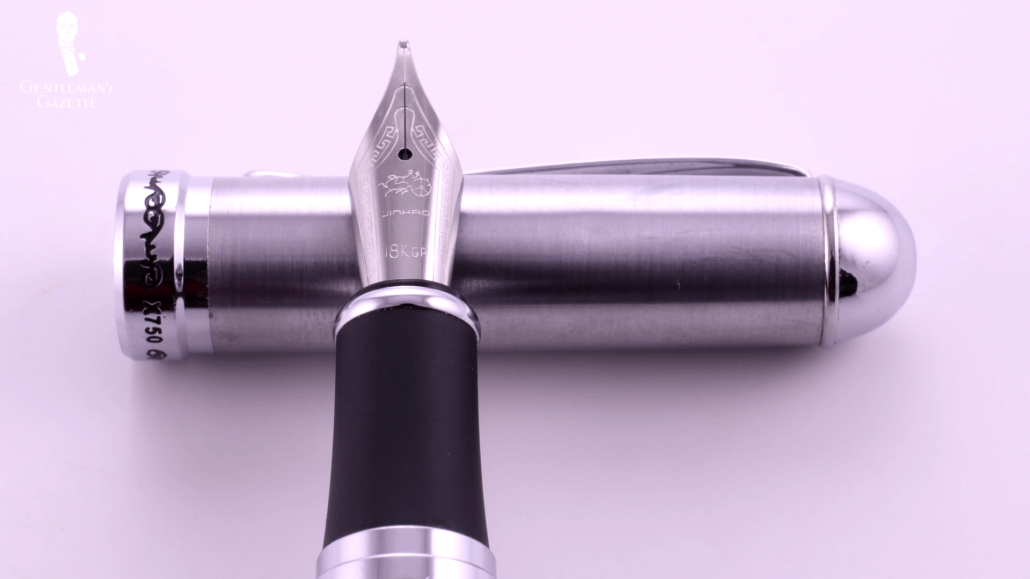
The brand name engraving on it looks rather cheap, but at the end of the day, it is a cheap fountain pen. It’s very similar to the X450, but it’s more lightweight. If you want to try them out, you can get both without having to spend so much and have an extra in your arsenal.
Price Point: Retails around $8
Beginner Fountain Pen Mistakes
5. Lamy Safari – Inexpensive Fountain Pen Made in Germany
Lamy pens are made in Heidelberg, Germany, which is very close to my home state. When I was in third grade, this was the fountain pen I used. Because of its sleek design and look, you can even see sometimes people today wearing it with their bespoke suits. This is ironic because it was a school pen that I used. For the same reason, I just can’t get myself to use that pen today because it always makes me feel like a little school pupil.

the budget edition
Made of Plastic
The standard version of the Lamy Safari fountain pen is made out of plastic. You can also find different versions of metals, such as aluminum, but in Raphael’s experience, they dent very easily and scratch, so they don’t look very well. Going with the original plastic version is just fine.
The styling is definitely the most industrial one in our list today, but it’s very comfortable in your hand and it’s very easy to grip for small and medium hands. If you have really large hands, I find the Lamy Safari is not quite the right pen for you.
Lamy was quite smart, and they introduced the proprietary ink cartridges, which are much larger than regular ones but also more expensive. They also have ink converters but you have to buy them separately, and they are not part of the package as for the Jinhao. Unlike the other pens in our lineup, the Lamy Safari has a convenient ink window so you can see if the pen is dried in or if you simply ran out of ink.
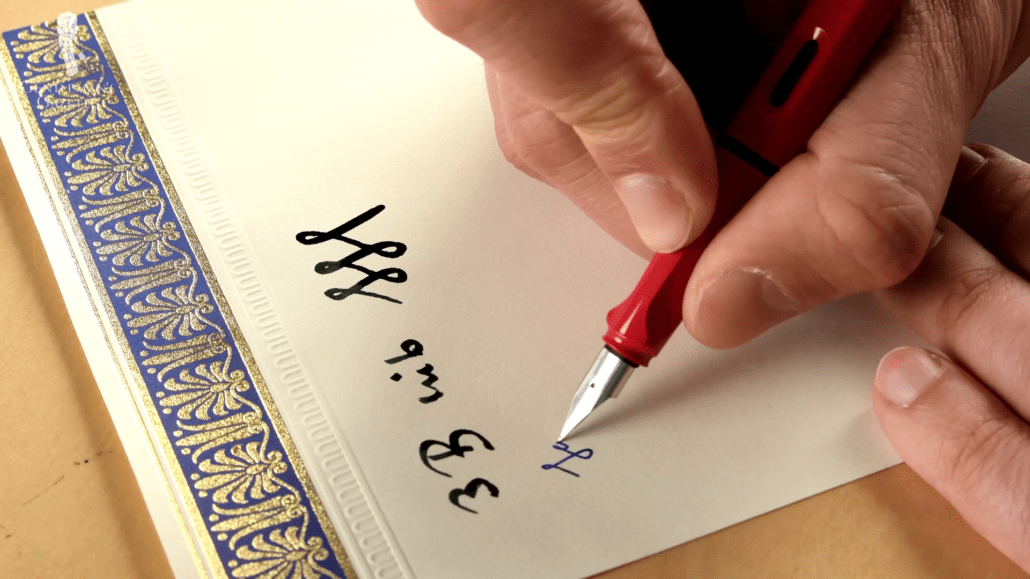
The Lamy Safari nib is smooth right out of the box and it comes in different nib widths as well. It’s also easy to exchange the nibs in different widths and because it is such a popular pen, it comes in many different colors and patterns and varieties. The Lamy Safari is the most expensive of the bunch today and costs a little over $20, depending on where you buy it.
Price Point: Retails between $20-$25
Buying a Fountain Pen for the First Time?
Conclusion
Fountain pens are not the most typical writing instrument of today, and there aren’t too many who know and appreciate them, it shouldn’t stop anyone from trying it out. Moreover, there are affordable options when you just want to pique your interest in what is believed to be the pinnacle of writing instruments. It could improve your handwriting and make it unique as well.
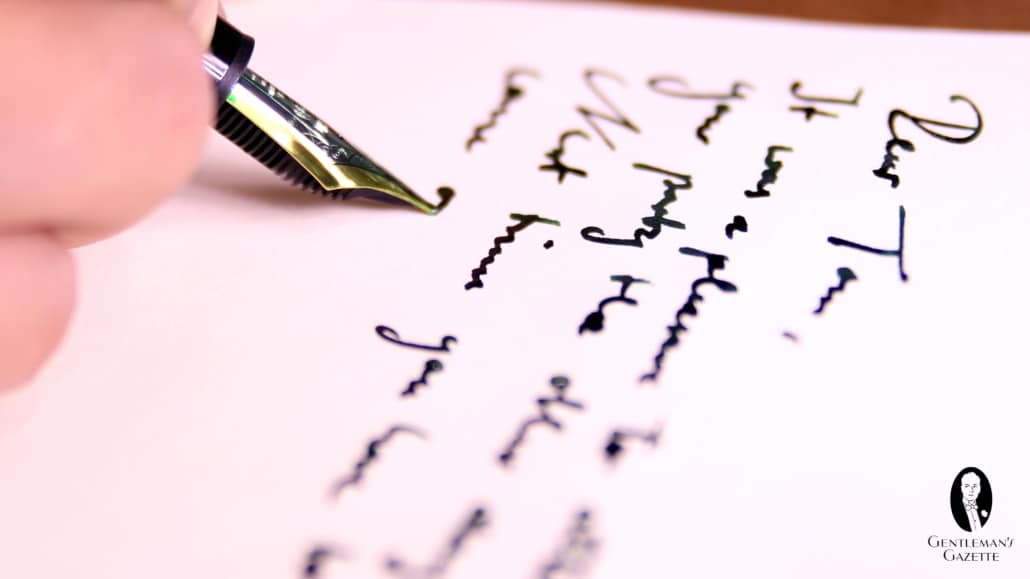

If I had to choose just one fountain pen out of the five, it would probably be the Pilot Metropolitan in an F or fine nib because the medium is something you find in many nibs, so fine is a little different. It also has an ink flow that it’s not as strong, so you can basically write on it with any paper without risking it bleeding. It also has a heavier weight than the Lamy Safari and to me, it’s a more professional-looking pen, and it doesn’t have that schoolboy image.
All the pens mentioned here can be used by right-handed and left-handed people. We suggest you go out and try them out. You can even buy two or three different ones to see which ones you like more and then write it up for a little bit.
If you really fall in love with them, you’ll probably want to invest in a more expensive piece that has nicer materials and a nicer nib because, that way, it remains a good investment and could last a lifetime.
Best Mid-Range Fountain Pens: $100-300
Budget Fountain Pen Recommendations
| Model | Brand | Origin |
|---|---|---|
| Pilot Metropolitan | Pilot | Japan |
| Pilot Varsity | Pilot | Japan |
| Jinhao X450 | Jinhao | China |
| Jinhao X750 | Jinhao | China |
| Lamy Safari | Lamy | Germany |
| Platinum Preppy | Platinum | Japan |
| Pilot Kakuno | Pilot | Japan |
| Kaweco Sport | Kaweco | Germany |
| Platinum Plaisir | Platinum | Japan |
Outfit Rundown

Raphael is wearing a summery outfit which consists of a royal blue polo shirt paired with bleeding madras cotton shorts. The shoes are vintage-inspired canvas sneakers from PF Flyer, which he finds comfortable and breathable, especially in the summer months.


Just got a safari and it’s worth it.
Safari is great.
About thirty years ago, a Duofold. Still have it.Finest kind.
A modern one, I suppose?
I would like to add the TWSBI Eco. It is a demonstrator (clear plastic) that allows you to view the machinations of the piston. It is a nice size and writes very smoothly. The ink flow is also smooth. The only caveat I have is to be careful when tightening the nut that attaches the ink feed. It comes with a plastic wrench to disassemble it, but if you strip it, you may not be able to clean the inside. The Eco retails for about $30.
Fountain pens are not practical for left-handed people. The ink simply does not dry quickly enough, so my hand smears it. I would pretty much have to relearn writing from first principle, so no thank you – I will stick with my gel-pens and avoid the mess!
I’m left handed and still very much like the experience of writing with a fountain pen, being careful of smears, of course, not hurrying.
Yes, I admit it is more difficult for left-handed people. Because of that, 50 years ago many young kids were forced to write with their right hand, even if they were left-handed. When I was in school kids who were lefties just learnt how to write fountain pens with their left hand, but it is perfectly understandable that you do not want to do that.
I’m left handed and use fountain pens daily with zero issues.
You shouldn’t make such definitive statements.
I’m a lefty. I’ve used fountain pens in the past, but I always smear. How do you avoid smearing?
I found this really beautiful Schaeffer gold and brown striped fountain pen, along with a matching mechanical pencil, among my grandfather’s things. It’s from the 40s, I think. I bought some ink, but I’m hesitant to try to load it. It has something on the non-business end that looks like a syringe which might be used to draw ink into it. Is there anything I should do before trying to use it?
I’ve used fountain pens for years and appreciate the experience, it makes me slow down, becomes meditative, present. With that said, I have invested money in Mont Blanc (many and all very very good), pelican (less expensive), Visconti (very good), Waterman. I tend to like medium nibs, depending on the nib flow, the fine and extra fine nibs seem wimpy and unmanly. The paper quality is becoming supremely important to me ( Sven, you may consider developing a talk about this sometime, finding good writing paper is difficult). But I say the Lamy pens, of which I have four, is of very good even with the steel nib, surprising to me (I have no financial interest is the company.) Moreover, do not buy Chinese pens that claim to be like Mont Blanc or other fine pens. They usually run about $100-200. They are fake and have horrible performance. I learned my lesson and after talking to a Mont Blanc rep from Germany in one of the American stores, my eyes were wide open regarding this shady business. I love the Japanese papers that are available.
Best regards
I have a Metropolitan, a nice pen as well as a Pilot Knight, a Lamy Safari with an EF nib (my daily carry), a couple of Jin Haos, the two you mentioned, and a Levenger True Writer with a F nib. I also have my late mother’s Esterbrook with a court reporter’s nib. When the Parker T-Ball Jotter came out, she bought one and never looked back. Yes, she was a court reporter when she was younger.
About 40 years ago I was given a Parker 61 in the lovely “cirrus” style and it is still my favourite pen to write with and it also got me into buying fountain pens. My collection which is primarily Parker includes examples of “Sonnet”, “Falcon/50” another “61” and a “65” along with about 30 other gold filled writing instruments but my for an every day fountain pen I still think that you have to go along way to beat the “25” which you can pick-up on auction sites in the UK for about £10. Incidentally, that is about the price point that I paid for my first one way back in about 1985 and it still writes as well today as it did then. I accept that this is more expensive than the ultra inexpensive pens in the article but I would rather pay a bit more and get something so long lasting.
I always thought that it was a shame that Parker didn’t offer a gold filled version of the “25” especially when they did on the “45” which wasn’t that much more expensive than the “25” when they were both in the range.
I think that for the money, a vintage Parker 51 or even a Parker 21 has these all beat hands down. You can pick up a Parker 51 “Special” in a common color in user condition for less than $100. The later aerometrics typically can be brought back to life with warm water and a lot of soaking even if they have been in a drawer for decades. Top of the line workmanship, real lucite, real silicone, real stainless steel, and a real iridium nib. I have a bunch I have cleaned up over the years, that I like to think lasted the original owner’s lifetime, will last my lifetime and then someone else’s too.
From my private school Hyde Park College in West London during the 50/60’s we always used the fine Parker 51. Moreover a great treat was to visit the Parker Service Center at the end of The Strand. There they would service your pen, change the nib if necessary and advice generally all for FREE in those days. This created strong brand loyalty. I still retain my collection of about six 51’s but rarely use now.
Splendid as always! I frequently carry an extra Jinhao to give away if someone queries beyond the surface about fountain pens. Though not what I use, the Jinhao are remarkably robust, well-made pens. I have probably bought/gifted two dozen, and all have worked flawlessly. On converters: As the plunger or twist knob takes up space in the pen barrel, one can cut a cartridge and, using Pliobond or contact cement, affix an ink sack fitted to fill the remainder of the barrel–it becomes a squeeze converter which frequently holds twice the ink of a plunger converter. Finally, antique shops are a splendid place to acquire broken, vintage pens, which can frequently (but not always) be revived with very little effort.
Write on!
Another great article!
I would add the Jinhao 159, the Wing Sung 3008 and 698 (both piston fillers). Unfortunately, my favorite inexpensive pen — the Waterman Phileas, has been discontinued. I purchased several at Office Max for $10.00 The Kulture is a similar pen and can still be found for a reasonable price.
Ditto that. And the Kulture parts are interchangeable to repair Phileas.
Ditto the Phileas. I have two and love them. One I acquired from a second-hand store and it hAd served it’s previous owner for several years. Didn’t get used very often though. I also have a couple Lamy pens. Great entry-level fountains. I am going to have to buy some cheap Jinhao. Live the idea of gifting them to the curious.
Hello Sven: I had in school a Shaeffer pen and later on a Parker. Over the years I became very fond of them. I wonder why I have not mentioned them. In my country (Argentina) they have always enjoyed a high reputation. I am very fond of handwriting, and I do it as often as I can. I would like to know your opinion about these two brands. Best regards.
I started using fountain pens about four years ago and I’ve used several inexpensive models. The Pilot Metropolitan is indeed an excellent choice for a beginner pen; I’m amazed that such a great writer is available at this price. I’ve had a couple of Lamy Safaris and I liked them except for inconsistent ink flow with a number of different inks. It costs a bit more than the beginner models listed here, but the TWSBI Classic, at around $50, is a great value; it writes smoothly and consistently and it’s a piston filler, which is rare at this price. I also have a Sailor 1911L (~$250), which is a very smooth writer with a 21k solid gold nib. The plastic body is nothing to write home about, but it looks nice; and it’s mostly about the writing experience.
I almost forgot to mention a great source of information for those new to fountain pens. The Goulet Pen Co. (gouletpens.com) has a Resources section with tons of articles and videos about fountain pens, inks, paper, and more.
Yes, they tried that at my school abd my mom told them in no uncertain trrns that i eas left-handed.
I got my first fountain a Parker 45, my junior year in high school. 1963. Still have it, and a few more now.
What do you think of the Pilot. 3 fountain pen with a EF nib?
Jakob.Kanis
At the lower price end there are Noodler Pens, made in the USA and are cheap but durable.
This pen features a slide piston pump action for filling.
https://www.gouletpens.com/collections/all-fountain-pens/products/
noodlers-ahab-flex-fountain-pen-tiger?variant=11884729565227
In the medium price range get a Conklin Duragraph pen.
In 1923, the Duragraph model was launched, and shortly afterwards was considered to be “the definitive” pen.
The model was named by combining the words, durable and graph – Duragraph. Created to last as an heirloom to serve many generations, the Duragraph is offered with a lifetime guarantee.
Select the fine nib, although you can get an “omniflex” nib that allows opening of the nib by pressing down
with the pen to make wider lines, but it probably shouldn’t be for the beginner.
https://www.gouletpens.com/collections/all-fountain-pens/products/
conklin-duragraph-fountain-pen-cracked-ice?variant=12289027342379
My favorite manufacturer of pens is Pelikan. They are made in Germany and last a lifetime.
The Pelikan M205 Blue-Marbled series is a fascinating mix of different shades of blue that gives the pen
a deeper depth of color. The silver rings and trim complement the elegant blue marbled texture.
https://www.gouletpens.com/products/pelikan-m205-fountain-pen-blue-marbled?variant=11884874301483
You can pay whatever you want for a fountain pen. The high end of Pelikan pens are expensive.
check this out:
variant=12745296445483
REMEMBER you MUST use fountain pen ink for fountain pens. “Art ink”, “Indian ink”, etc. will clog
a pen very quickly. Fountain pen ink is a dye. Noodlers makes excellent ink in many colors and you can
get whatever color(s) you want but it would be better to begin with black or dark blue ink.
Black ink: 3oz (90ml) glass bottle of Noodler’s Dark Matter fountain pen ink. Noodler’s inks are
handcrafted, so there may be slight color variations from batch to batch.
https://www.gouletpens.com/collections/bottled-ink/products/noodlers-dark-matter-3oz-bottled-ink?
variant=11884738445355
Dark Blue ink: 3oz (90ml) glass bottle of Noodler’s Baystate Blue fountain pen ink.
https://www.gouletpens.com/collections/bottled-ink/products/noodlers-baystate-blue-3oz-bottled-ink?
variant=11884737626155
Good luck,
Paul
The Jinhao 159 is the size of a Montblanc Meisterstück 149 and a darn good knock-off too. It’s well made, rather heavy and simply has a quality feel; plus, the price is about $12.50. Install a higher quality Goulet #6 nib of your width choice ($15.00) and you have a very nice writing fountain pen for under $30. It comes with a piston filler for bottled ink and will accept standard short or long international cartridges as well. The best entry level deal I have found to date.
I couldn’t agree more with your take on the Pilot Metropolitan. I have one in the fine nib and it writes very nicely despite my left handedness. I have found that many other inexpensive pens do not work well for us lefties. I also have a Hero that was quite inexpensive but impressive in looks and it writes extremely well for the price. My favorite is a Xezo that my wife got for me for our anniversary one year but that one is more expensive and finally I have a Parker that I bought just because we used to use them in school. I love writing with these pens; it makes me feel classy!
Thanks for sharing, Joe.
I have a nice collection of rather Shaeffers piston pens that were handed out at large business deal signing ceremonies, but my preference goes to Montegrappa, although one cannot say that they fall in the “inexpensive” category.
A Parker 51. A present from my dad. Still working, still an impressive writer. Never fails.
I love fountain pens. I much prefer vintage and have a small collection. Sone parkers, some sheaffers and my favourite the 19230s Onota. I personally prefer vintage pens to those made today. It is the feel and designs. Vintage pens are still cheap and will serve many more years of service.
Sven, I love writing with a fountain pen. My oldest is an Estabrook from my elementary school days. Being left-handed, I wrote with the overhand style until my lefty aunt showed me how to write in the underhand style which resulted in the traditional left-leaning letters. Notebooks from the 50’s are surprisingly legible. As an architect for over 50 years, drawing and lettering in underhand style is still preferred to computer use. Finding good writing paper is hit or miss as few sales people are little more than stock boys.
My college pen is a fat 1960’s Sheaffer White Dot snorkel model with a ‘signature stub’ nib about 0.1cm -1/16″ wide and a rounded underside used for printing in blue/black ink. The second is a newer Sheaffer White Dot with a squeeze converter also with the engaged nib in a full ball medium tip used for general writing in turquoise. The ball makes ‘pushing left-handed style’ acceptable. I have a third Sheaffer in a more traditional nib style fine tip also with the rounded point and brown ink for ledger entries and record signatures where photocopying is prohibited. I use the Sheaffer brand inks. Bromfield Pen Shop on Bromfield St., Downtown Boston is my favorite source of service and Christmas shopping. I have several other pens from Staples that serve as pocket pens for signatures and notes on the jobsites where loss is expected. With black ink cartridges, they are still better than ball point for sketching. Great subject well written. Thank you, Geoff.
Good article. Suggest the KING NIB fountain pen set.
http://www.kingnib.com
Speaking as one who has acquired dozens of fountain pens, from the cheapest Chinese products to fancy pens from Italy, I want to recommend the pens of a brand that has only recently come to my attention: Asvine. I have bought three pens of this brand and liked every one of them. I find them to be more reliable than the Jinhao pens, which I have found often to be hard starters, and I happen to find the designs more attractive. The nibs are of high quality, and with some models there is an option to get a Bock nib, if you prefer that brand.
https://www.ebay.com/sch/i.html?_nkw=Asvine+fountain+pen&_sacat=0
I recommend the Asvine V126 vacuum filler especially strongly. This is a knock-off of the Pilot Custom 823 at about a tenth of the price. I have one in amber that I find more enjoyable to use than my Pilot 823.
I also have a P36. It costs a bit more and is rather heavy for my tastes, but it is an extremely cool pen and functions well.
I have not tried the P50, which is a knock-off of the Leonardo Officina pens. Since I own so many of the latter, I am not inclined to get an imitation of them, but some may prefer this design.